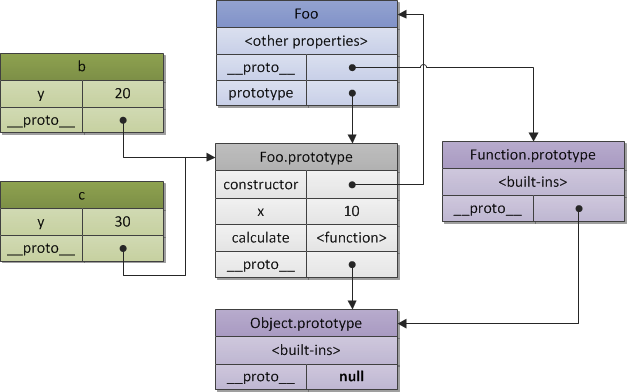除了創建對象,構造函數(constructor) 還做了另一件有用的事情—自動為創建的新對象設置了原型對象(prototype object) 。原型對象存放於 ConstructorFunction.prototype 屬性中。
例如,我們重寫之前例子,使用構造函數創建對象“b”和“c”,那麼對象”a”則扮演了“Foo.prototype”這個角色:
// 構造函數
function Foo(y) {
// 構造函數將會以特定模式創建對象:被創建的對象都會有"y"屬性
this.y = y;
}
// "Foo.prototype"存放了新建對象的原型引用
// 所以我們可以將之用於定義繼承和共享屬性或方法
// 所以,和上例一樣,我們有了如下代碼:
// 繼承屬性"x"
Foo.prototype.x = ;
// 繼承方法"calculate"
Foo.prototype.calculate = function (z) {
return this.x + this.y + z;
};
// 使用foo模式創建 "b" and "c"
var b = new Foo();
var c = new Foo();
// 調用繼承的方法
b.calculate(); //
c.calculate(); //
// 讓我們看看是否使用了預期的屬性
console.log(
b.__proto__ === Foo.prototype, // true
c.__proto__ === Foo.prototype, // true
// "Foo.prototype"自動創建了一個特殊的屬性"constructor"
// 指向a的構造函數本身
// 實例"b"和"c"可以通過授權找到它並用以檢測自己的構造函數
b.constructor === Foo, // true
c.constructor === Foo, // true
Foo.prototype.constructor === Foo // true
b.calculate === b.__proto__.calculate, // true
b.__proto__.calculate === Foo.prototype.calculate // true
);
上述代碼可表示為如下的關系:

構造函數與對象之間的關系
上述圖示可以看出,每一個object都有一個prototype. 構造函數Foo也擁有自己的__proto__, 也就是Function.prototype, 而Function.prototype的__proto__指向了Object.prototype. 重申一遍,Foo.prototype只是一個顯式的屬性,也就是b和c的__proto__屬性。
這個問題完整和詳細的解釋有兩個部分:
面向對象編程.一般理論(OOP. The general theory),描述了不同的面向對象的范式與風格(OOP paradigms and stylistics),以及與ECMAScript的比較。
面向對象編程.ECMAScript實現(OOP. ECMAScript implementation), 專門講述了ECMAScript中的面向對象編程。
現在,我們已經了解了基本的object原理,那麼我們接下去來看看ECMAScript裡面的程序執行環境[runtime program execution]. 這就是通常稱為的“執行上下文堆棧”[execution context stack]。每一個元素都可以抽象的理解為object。你也許發現了,沒錯,在ECMAScript中,幾乎處處都能看到object的身影。
下面給大家介紹JavaScript constructor 屬性詳解
對象的constructor屬性用於返回創建該對象的函數,也就是我們常說的構造函數。
在JavaScript中,每個具有原型的對象都會自動獲得constructor屬性。除了arguments、Enumerator、Error、Global、Math、RegExp、Regular Expression等一些特殊對象之外,其他所有的JavaScript內置對象都具備constructor屬性。例如:Array、Boolean、Date、Function、Number、Object、String等。所有主流浏覽器均支持該屬性。
語法
object.constructor
返回值
對象的constructor屬性返回創建該對象的函數的引用。
示例&說明
以下代碼中的[native code],表示這是JavaScript的底層內部代碼實現,無法顯示代碼細節。
// 字符串:String()
var str = "張三";
document.writeln(str.constructor); // function String() { [native code] }
document.writeln(str.constructor === String); // true
// 數組:Array()
var arr = [1, 2, 3];
document.writeln(arr.constructor); // function Array() { [native code] }
document.writeln(arr.constructor === Array); // true
// 數字:Number()
var num = 5;
document.writeln(num.constructor); // function Number() { [native code] }
document.writeln(num.constructor === Number); // true
// 自定義對象:Person()
function Person(){
this.name = "CodePlayer";
}
var p = new Person();
document.writeln(p.constructor); // function Person(){ this.name = "CodePlayer"; }
document.writeln(p.constructor === Person); // true
// JSON對象:Object()
var o = { "name" : "張三"};
document.writeln(o.constructor); // function Object() { [native code] }
document.writeln(o.constructor === Object); // true
// 自定義函數:Function()
function foo(){
alert("CodePlayer");
}
document.writeln(foo.constructor); // function Function() { [native code] }
document.writeln(foo.constructor === Function); // true
// 函數的原型:bar()
function bar(){
alert("CodePlayer");
}
document.writeln(bar.prototype.constructor); // function bar(){ alert("CodePlayer"); }
document.writeln(bar.prototype.constructor === bar); // true